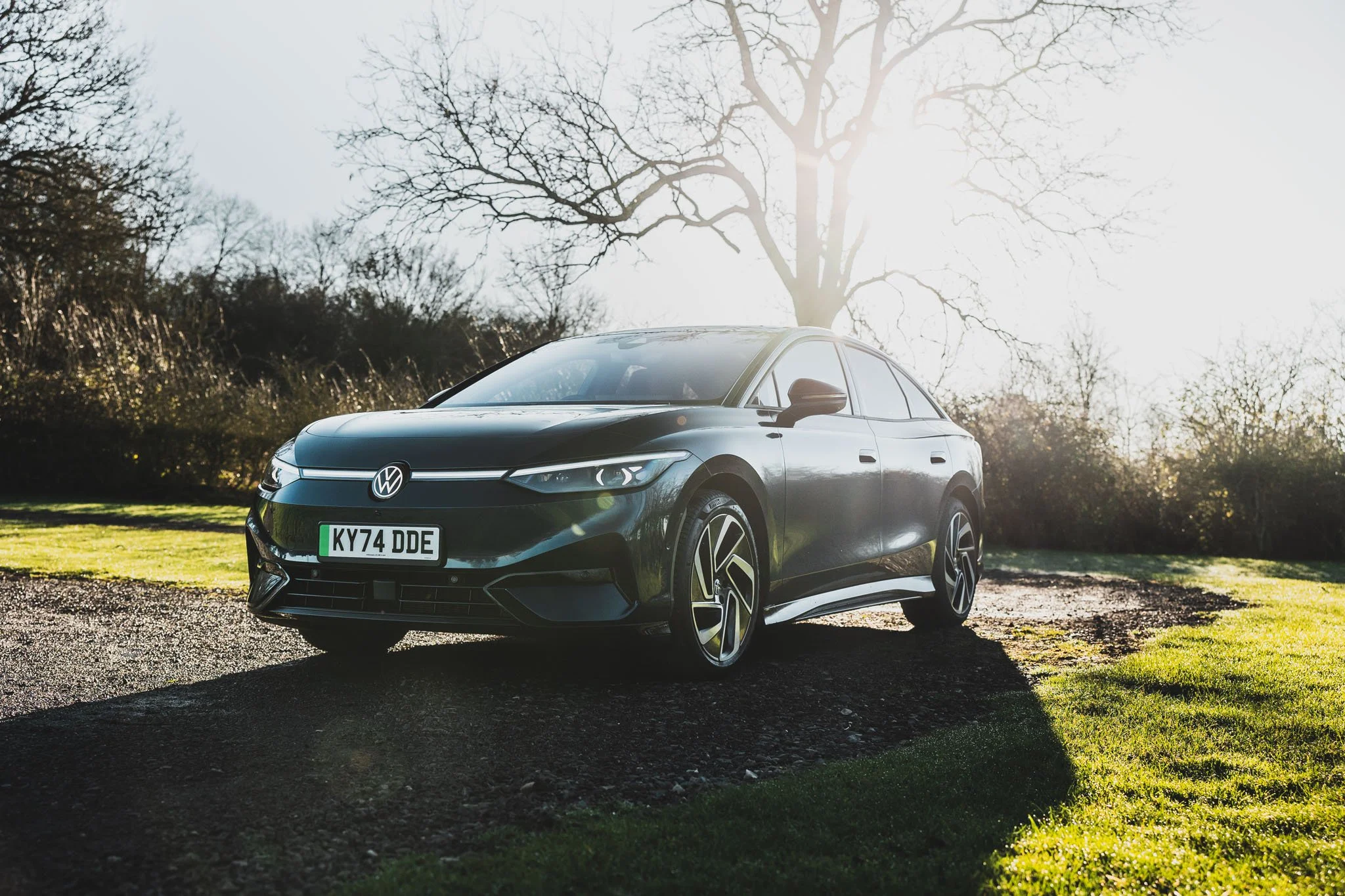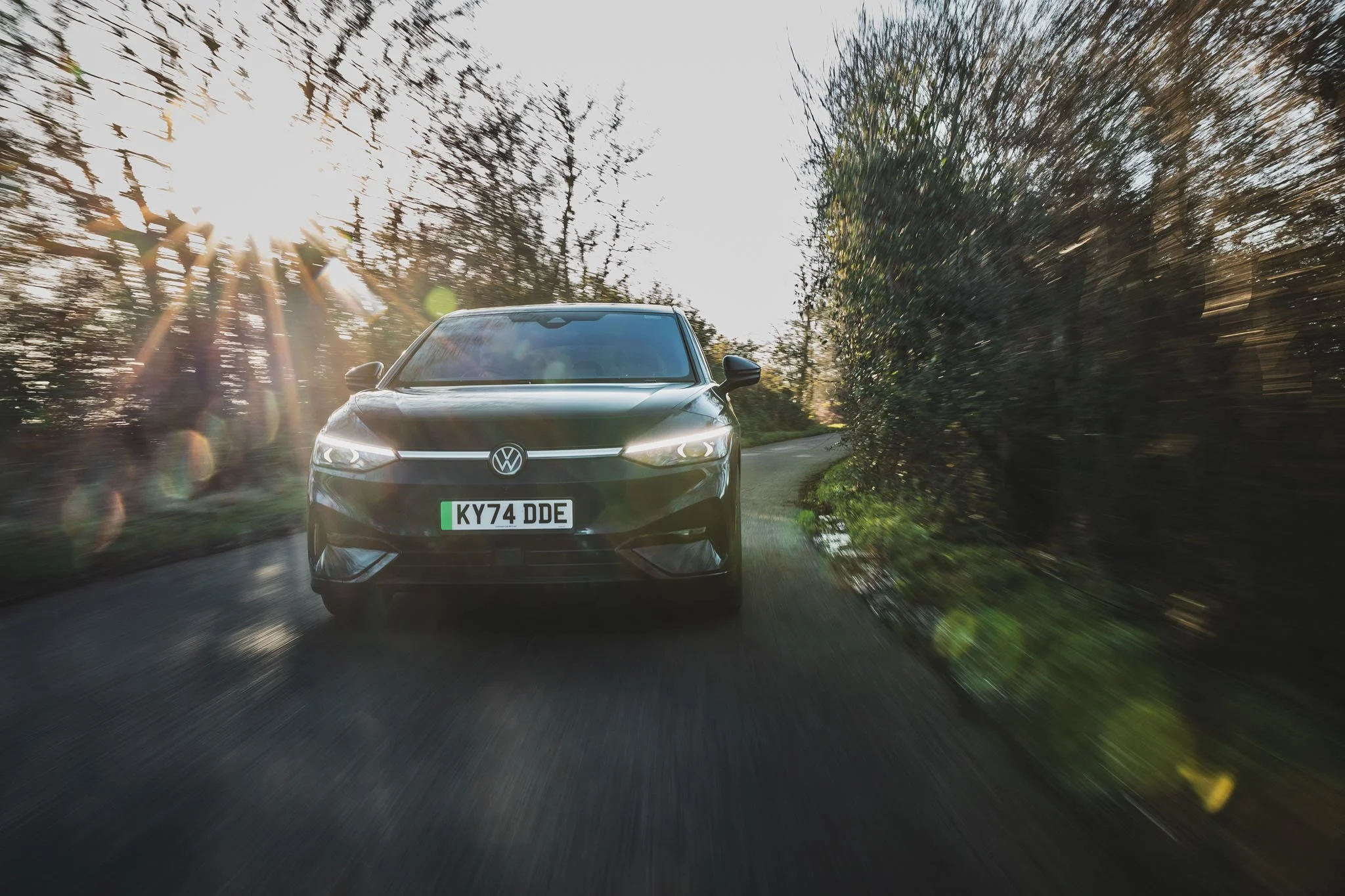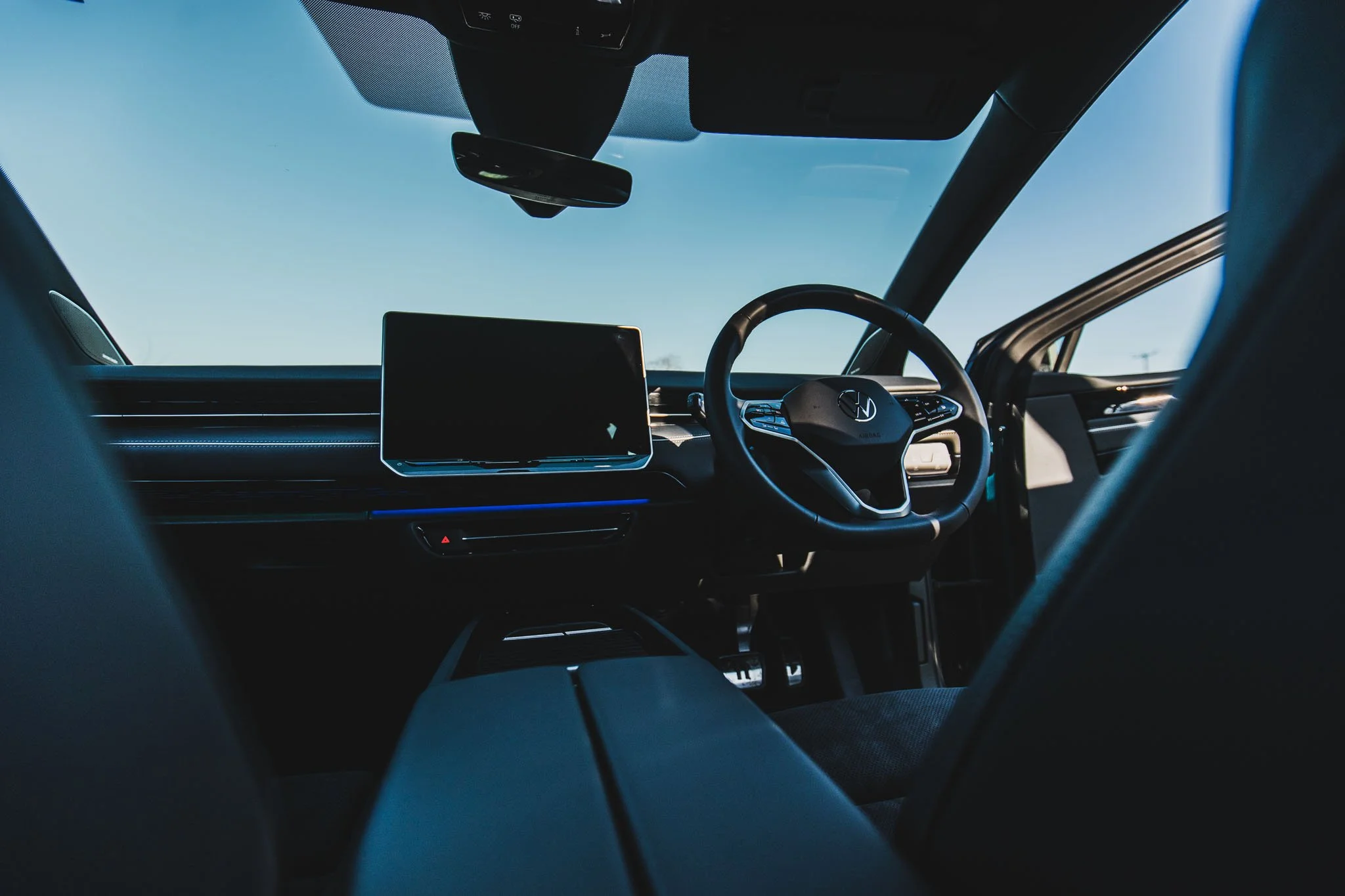VW ID.7 Pro S Match - An (as yet) Unsung Hero
Weather Warning: It's still winter.
For the 2nd time in as many weeks, I’m opening a review with a complaint about the British weather. It’s still winter, and as a result, it’s still horribly bitterly cold. Fortunately, the subject of this week’s review is a car rather than a motorcycle (which granted me the right to have a proper moan in my last article). Despite the fact that the vehicle I’m testing has four wheels, doors, and double glazing to shield me from the minus Celsius figures outside, there is still a significant downside that comes with the seasonal temperatures because this week I’m in an EV.
The Volkswagen ID.7 is, like all IDs, fully electric and, therefore, subject to a drop in battery performance when the temperature drops. Unlike in my last review of the Triumph Motorbike, I’m not going to grant an entire opening paragraph to complain about winter in the UK because, frankly, that’s dull, and the ID.7 is far from dull... It's superb.
A Great-Looking Saloon Car
The first thing that must be celebrated about ID.7 is its shape. When large EVs first burst onto the scenes en-masse a few years ago, the majority all seemed to be blobby egg-shaped SUVs, and yes, many of them still are blobby egg-shaped SUVs, but now, we're starting to see more electric cars in the shape of - cars - like this. I think the ID.7 is a genuinely good looking car. The proportions all make sense, the flush door handles add a touch of class, and to the unsuspecting eye, the ID.7 is simply a smart follow-on from the stylish and simplistic list of family cars that VW has been producing for decades.
The ID.7 has a familiar and typically classless design, something VW's designers have excelled at since the 1970s. Sure, there are posher-looking cars in the segment and plenty with more radical designs, but that's not the point of the ID.7. This is a car that simply blends in and gets the job done quietly - and I like that.
The Passat's Days are Numbered
It's important to mention that the ID.7 has inevitably arrived to replace VW's long-serving family car, the Passat. As I write this, you can still buy a Passat, but when the time comes for the EVs to replace the internal combustion-powered old-timers, the ID.7 is what the salesperson at your local VW showroom will be offering in part exchange for your diesel-powered Passat.
Like the Passat, the ID.7 is available as a saloon car like the one I have on test or as an estate version, which offers more rear storage and better access for the family dog. The model I've been driving for the past 2 weeks is the ID7 Pro S Match.
Power and performance
Powering the car is a 77kWh battery, which produces 282 hp and 545 Nm of torque. On the Pro S, all the power goes to the rear wheels via a single-speed motor. In the saloon format, the ID.7 has a drag coefficient of 0.23cd (the same as a Tesla Model 3) and returns a potential (best case) combined consumption of 4.5 miles/kWh. The Pro S Match takes off from a standstill and will reach 62 mph in 6.6 seconds, with an eventual top speed of 112mph - which is pretty nippy considering its 2.2-tonne kerb weight.
Charge times are reasonably nippy, too, with a 200kW rapid charge rewarding 10-80% in as little as 26 minutes, or if you're plugging in at home with an 11kW wall box, a full charge should take around 9 hours. On a couple of occasions, with battery preconditioning, I saw a charge from 10% to 100% in just under 40 minutes, which is superb.
The Reality of Range in the Winter Months
Volkswagen claims that with some very economical driving, the ID.7 Pro S Match can achieve 436 miles on one charge; however, you must take that figure with a big ol' pinch of salt, especially at this time of year. In the two weeks that I've had the ID.7, I charged the car a few times to 100%, and the best predicted range I've been rewarded with was 282 miles - 154 miles less than the best-case WLTP.
Interestingly, on the day of writing this article, VW published a proud press release detailing how an ID.7 Pro S covered a staggering 941 km (584 miles) on one charge in a special test on the Low Speed Ring at the Nardo testing facility. It's an incredible headline. But like so many of these tests, it was carried out in a controlled environment, and the average speed for the entire test was just 18mph, which is not comparable to the driving I'd be subjecting my press car to and probably not what the average buyer will be doing either.
But, fair dues to the press car, it is mid-winter and therefore freezing cold, which does take its toll on battery performance. Also, thanks to the weather, I'm driving with heated seats and a heated wheel almost constantly switched on, and I'm blasting heat from climate control to keep me warm - all of which take their toll on the overall range.
The true cost of public charging
A trip to Lands End in Cornwall was required for a podcast recording, and I decided the ID.7 was the perfect choice to get me there and back. A common concern for EV buyers is that the idea of their annual family holiday to the West Country from London will be a hellish nightmare due to the need to plug in at some point. Well, I'm pleased to report that my journey was an absolute breeze.
A full charge in Exeter (my journey midpoint from Warwickshire) comfortably rewarded me with just the right amount of range to get me to Lands End and back (around 255 miles) on a mixture of 70mph duel carriageways and motorways and some fantastically hilly country lanes before another full charge back at Exeter was required to get me home again. The good news is that infrastructure is getting progressively better at a fantastic rate.
The downside to public fast charging is the cost. My 530-mile mid-winter journey required three full charges, which cost around £45 each time. At that price point, completing the journey in my 3.0L diesel Land Rover Defender would have been marginally cheaper; however, if that sort of mileage is something you're likely to do only once or twice per year, the overall saving on servicing and maintenance against an ICE equivalent is likely to make up for the difference.
Size and space
The ID.7 is a big car at 4.9 metres in length and 2.1 metres in width. The size is most noticeable when parking, as the ID.7 only fits in a typical parking space. A perk of the exterior dimensions is internal space and storage. The ID.7 has an impressive 532 litres of boot space, and being a hatchback means loading larger items into the rear is more effortless than some competitor vehicles with a less convenient boot lid.
The space is palatial for rear passengers, with plenty of legroom for adults over 6 feet tall. Up front, the space is resemblant to an SUV, with plenty of practical storage options, including door pockets lined with felt to stop unwanted sounds of keys and other loose items sliding around.
Even at entry-level price brackets, the ID.7 interior is finished with some great materials, but if you don't mind spending a little bit on some optional extras, you can end up with a saloon car that rivals the really posh stuff.
Prices and optional extras worth ticking
Prices for the ID.7 start at £55,480, which offers a few nice features as standard, including Metallic Paint Work, 19" alloy wheels, privacy glass, a rearview camera, a large 15" infotainment screen in the centre console and an augmented reality navigation, which is fantastic.
This press car has a couple of option packs ticked which bumps the price up to £60,060.00. The options include the 'Exterior Pack Plus with the electronic darkening sunroof', which costs £2,100. The pack contains adaptive chassis control, driving profiles illuminating badges on the front and rear and sound-insulated glass at the rear of the car.
It also has the Interior Pack Plus - which has a price tag of £2,000 and offers a Harmon Kardon Sound system, upgraded ventilated massaging seats up front and some luggage storage nets in the boot. This package is well worth the money, almost for the massaging seats alone. The Harmon/Kardon sound system is also a great perk, with a selection of quick and easy audio presets for everything from podcasts and spoken radio to different styles of music.
What about the ID.7 GTX?
In the 2 weeks of having the ID.7, I've managed to cover over 900 miles with the car, and I can safely say that I can't find anything to moan about regarding the driving aspect because it's all excellent. There is a faster, dual-motor version of the ID.7 called the GTX, but personally, I wouldn't consider it. The GTX version starts at £62k before any options are ticked, and with the increase in power and weight from the extra motor, you lose range. The Pro S is all the family car you'll likely need, so save yourself some money and enjoy the better range.
D vs B driving modes
There are lots of aspects of the ID7 that I really like. As is the norm in most EVs, you have two Drive modes: D for 'Drive' and B for 'Brake'. In B, the ID7 has a more aggressive regenerative setting, which slows the car with the effect of engine braking but, in doing so, takes kinetic power and converts that to power for the battery. The alternative mode, 'Drive', impresses me most because lifting off the accelerator pedal holds the car at the speed limit when lifting off the throttle. In a 30mph speed limit, if you're driving at 28mph, lift off, and the car will remain at that speed whilst applying just the right amount of power to keep you going, alleviating the need to keep accelerating to keep the vehicle moving.
Luxuries as good as a Bentley
Driving aside, it was the unexpected luxuries that I enjoyed most. The upgraded seats are excellent. The massage function genuinely rivals systems I've experienced in £200,000 Bentleys, and the overall comfort of the seats on a long drive is terrific. Other features include 'Max Seat Heating', which is especially welcome on cold days and rapidly heats the front seats. For warmer days (or if you've overdone it with the heating), there is also an airconditioned ventilation system which jets ice-cold air through the base and back of the seat to regulate body temperature. There is even a rapid dry mode setting designed to assist in drying wet clothes if caught in a rain storm.
Another feature VW does particularly well is augmented reality navigation. When enabled, the navigation system offers guidance via the head-up display, which projects arrows to indicate turning points on the windscreen. It gives the effect of the arrows floating in mid-air ahead of you, which shows the exact point at a junction or to turn or exit a roundabout.
A Virtual Assistant that works!
The ID.7 is also equipped with IDA, VW's virtual assistant. You can speak to the car, give commands about setting the climate and navigation destinations or even ask about the weather forecast. The system also uses ChatGPT, meaning you can now ask the car about anything you need the answer to.
The Assisted Cruise Control is one of the best available.
I'm a real sceptic about assisted or intelligent cruise control systems, usually because I want them to be perfect, and they rarely are. While the ID.7's assisted cruise control does have its faults, on the whole, it's a very impressive system and is easily one of the best I've tested. When activated, the system steers, brakes, and accelerates while reading speed limit signs to adjust the cruise control speed on your behalf automatically. All adjustments to the speed and steering inputs are exceptionally gentle and smooth.
The only negative with the system, as seen in all cars with this technology, is that the sign recognition isn't always reading the right signs at the right times. Speed limit signs on the back of large trucks are sometimes read as limits for the road, which can result in the car speeding up or slowing down unexpectedly. The same effect can happen when passing road signs on adjacent highways or junctions, confusing the system and making it think the speed limit is incorrectly higher or lower than it should be. We're still a few years away from anyone coming up with a perfect assisted cruise control system, but I insist that the VW system is as good as the BMW tech and considerably better than Tesla's autopilot system.
Relaxing enough to be the new Phaeton?
Relaxing is a great word for the ID.7. It's a beautifully relaxing car to drive; it's exceptionally quiet, very comfortable and looks great. As previously mentioned, the ID.7 is here to step into the role previously fulfilled exclusively by the Passat, but honestly, with the right options ticked, I believe it's also good enough to fill the boots of an even more significant VW model of yesteryear, the Phaeton.
The ID.7 really is that good; it's quiet, refined, and above all, it feels like a very high-quality vehicle, which, like the Phaeton, would be just as pleasant to experience from the back seat whilst being chauffeur-driven.
I see the ID.7 as a bit of an unsung hero for EVs, but I doubt it'll remain unsung for long. It should be rightfully on the shortlist for anyone looking at EVs in this category, and I firmly believe it won't be easy to beat.
words: John Marcar
photography: Henry Faulkner-Smith





























